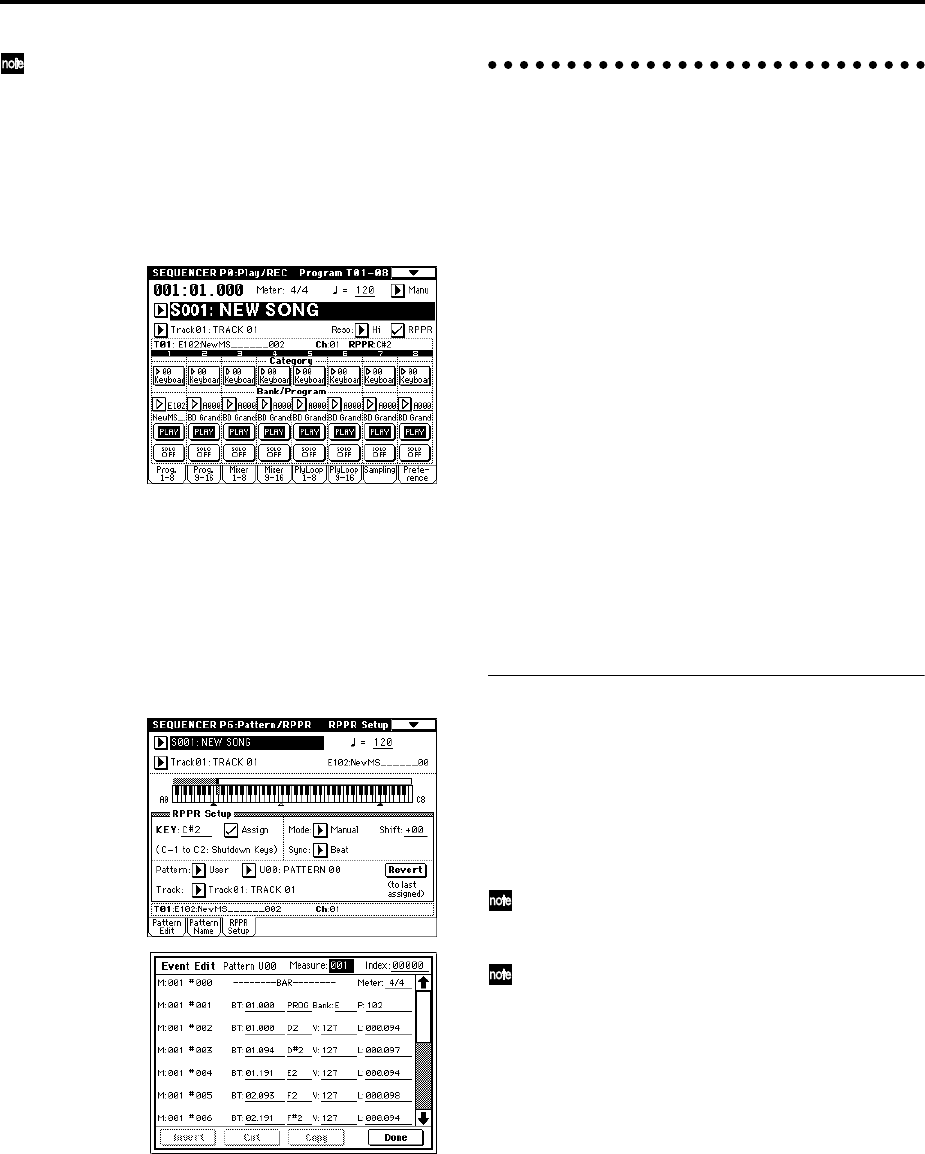
80
The silence between samples may become obtrusive
if you play back at a slower tempo, or noise may
occur between samples if you play back at a faster
tempo. To avoid such problems, you can set Stretch
“New BPM” or “Ratio” in step 6 to the tempo at
which you want to play back, and execute time
stretch to adjust the length of each sample. (☞PG
p.130 9)
9 In “Song Select,” choose 001.
The following song data has been set/created automat-
ically as you specified in step 6.
• P0: Play/REC page
Song: 001, Meter: 4/4, Tempo: 120, RPPR: On
• P0: Play/REC, Program T01–08 page
Track01 Program: E102
• P6: Pattern/RPPR, RPPR Setup page
Key: C#2, Assign: On,
Pattern: User, U00, Track: Track01
Pattern data: 1 measure (D2–)
In the P6: Pattern/RPPR, Pattern Edit page, press the
SEQUENCER [START/STOP] key to start playback of
pattern U00.
When you press the C#2 key in the P6: Pattern/RPPR,
RPPR Setup page, the RPPR function will start playing
pattern U00.
In the same way as in step 8, changing the playback
tempo will not affect the pitch.
Sampling in Program, Combina-
tion, or Sequencer modes
External audio sources can be sampled from the various
input jacks in Program, Combination, and Sequencer
modes as well.
A performance in the above modes can also be internally
resampled in digital form. You can resample a perfor-
mance that uses the TRITON Extreme’s full range of fea-
tures (filters, effects, arpeggiator, and sequencer).
You can also sample the TRITON Extreme’s performance
together with audio from an external input source, or
monitor the performance of the TRITON Extreme’s arpeg-
giator and sequencer etc. while you sample only the exter-
nal audio from the input jacks.
In Sequencer mode, you can sample external audio while
listening to a song play back, and automatically create
note data in the track that will play the sample when the
track is played back. This allows you to sample vocals or
guitar while the sequencer runs, just as though you were
using a multitrack recorder. (This function is called “In-
Track Sampling.”)
☞ For examples of sampling in Program and Combina-
tion modes, refer to QS p.22. The sampling procedure
in Combination mode is the same as in Program mode.
Sample an arpeggiated drum phrase
together with an externally-input guitar
Here’s how you can resample an arpeggiated perfor-
mance together with an external audio input source.
In this example, we will explain how a guitar connected to
the AUDIO INPUT jack can be played along to a drum
pattern played by the TRITON Extreme, and how both
can be sampled together.
Sampling can be performed in a similar way in Com-
bination and Sequencer modes as well as in Program
mode.
In this example we will send the external audio input
source to INDIVIDUAL 1, so if you want to monitor
the sound being sampled, connect AUDIO OUTPUT
(MAIN) L/MONO, R, and (INDIVIDUAL) 1 to your
mixer, and use headphones etc. to monitor the output
of the mixer.
1 Press the [PROG] key to enter Program mode, and
select the K020: Processed Kit program.
2 Turn on the arpeggiator (ARPEGGIATOR [ON/OFF]
key is lit), and play the keyboard to make sure that a
drum phrase is sounded.
Press the Arpeggio tab, and make sure that “Latch” is
checked.
Also adjust the arpeggiator tempo “” as desired.
3 Press the ARPEGGIATOR [ON/OFF] key to turn off
the arpeggiator.


















